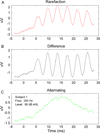Intraoperative round window recordings to acoustic stimuli from cochlear implant patients
- PMID: 23047261
- PMCID: PMC3632009
- DOI: 10.1097/MAO.0b013e31826dbc80
Intraoperative round window recordings to acoustic stimuli from cochlear implant patients
Abstract
Hypothesis: Acoustically evoked neural and hair cell potentials can be measured from the round window (RW) intraoperatively in the general population of cochlear implant recipients.
Background: Cochlear implant performance varies greatly among patients. Improved methods to assess and monitor functional hair cell and neural substrate before and during implantation could potentially aid in enhanced nontraumatic intracochlear electrode placement and subsequent improved outcomes.
Methods: Subjects (1-80 yr) undergoing cochlear implantation were included. A monopolar probe was placed at the RW after surgical access was obtained. The cochlear microphonic (CM), summating potential (SP), compound action potential (CAP), and auditory nerve neurophonic (ANN) were recorded in response to tone bursts at frequencies of 0.25 to 4 kHz at various levels.
Results: Measurable hair cell/neural potentials were detected to 1 or more frequencies in 23 of 25 subjects. The greatest proportion and magnitude of cochlear responses were to low frequencies (<1,000 Hz). At these low frequencies, the ANN, when present, contributed to the ongoing response at the stimulus frequency. In many subjects, the ANN was small or absent, whereas hair cell responses remained.
Conclusion: In cochlear implant recipients, acoustically evoked cochlear potentials are detectable even if hearing is extremely limited. Sensitive measures of cochlear and neural status can characterize the state of hair cell and neural function before implantation. Whether this information correlates with speech performance outcomes or can help in tailoring electrode type, placement or audiometric fitting, can be determined in future studies.
Figures







References
-
- Firszt JB, Holden LK, Skinner MW, et al. Recognition of speech presented at soft to loud levels by adult cochlear implant recipients of three cochlear implant systems. Ear and hearing. 2004;25:375–387. - PubMed
-
- Gomaa NA, Rubinstein JT, Lowder MW, et al. Residual speech perception and cochlear implant performance in postlingually deafened adults. Ear and hearing. 2003;24:539–544. - PubMed
-
- Francis HW, Niparko JK. Cochlear implantation update. Pediatric clinics of North America. 2003;50:341–361. viii. - PubMed
-
- Rubinstein JT, Parkinson WS, Tyler RS, et al. Residual speech recognition and cochlear implant performance: effects of implantation criteria. The American journal of otology. 1999;20:445–452. - PubMed
-
- Friedland DR, Venick HS, Niparko JK. Choice of ear for cochlear implantation: the effect of history and residual hearing on predicted postoperative performance. Otology & neurotology : official publication of the American Otological Society, American Neurotology Society [and] European Academy of Otology and Neurotology. 2003;24:582–589. - PubMed
Publication types
MeSH terms
Grants and funding
LinkOut - more resources
Full Text Sources
Other Literature Sources
Miscellaneous

